An affordable alternative to traditional heating - a gas heater for your home
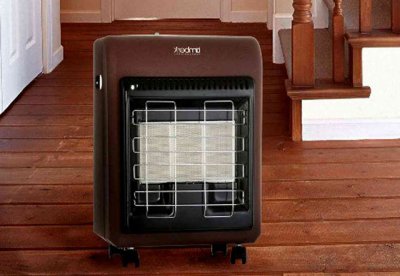
The gas heater is autonomous decentralized (as opposed to central heating with a boiler) a heating system.
It uses the energy released during combustion of natural gas to heat rooms.
Externally, this device looks like casing, with a gas burner installed in it and a heat dissipation panel, which is usually made of ceramics or metal alloys.
The gas cylinder can be built into the device body, but it can also be connected to the gas main.
Content
- Gas heaters for apartment buildings and private houses
- Classification by execution
- Classification by type of heat transfer
- How to choose the right one for heating your home
- Device with built-in cylinder: features
- A short overview of popular models
- Useful video
- A cost-effective replacement for central heating
Gas heaters for apartment buildings and private houses
Advantages of gas heaters:
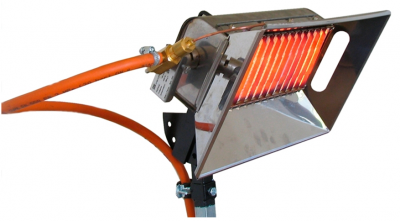
-
Autonomy, independence from electricity supply. Many of these devices can operate on both liquefied and natural gas.
Therefore, even if the main gas supply is disconnected or it is impossible to connect to it, the device can always be connected to a portable gas cylinder and not be left without heat.
- ReliabilityThese heating devices are simple in design, and there is no risk of burnout, as is the case with electric heaters on heating elements.
- High efficiency. Burning fuel directly at the heating site allows achieving values up to 80%.
Classification by execution
Depending on the design, the following types of gas heaters are distinguished.
Portable balloons
As a rule, they are made in the form of a housing with gas equipment and space for fixing the cylinder (there are also models with a cylinder connection through a hose). The sizes can be different: from miniature for heating tents on hikes up to overall and powerful, for heating large spaces.
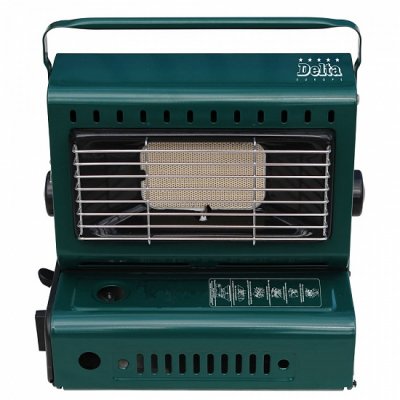
Powerful models, due to their size, are equipped with with wheels for easy transportation. The device body has an ignition button and a combustion intensity regulator.
Portable gas heaters operate on bottled gas only.
Exists two types of gas: natural and liquefied (can consist of both natural and various mixtures, for example, propane-butane). First view — supplied through main lines and used in stationary installations.
Liquefied - gas in a liquid state, it has bOgreater density and is pumped into cylinders, so it is more convenient for portable use. The device, designed only for natural gas, will not work on liquefied gas.
Heating devices of this type are used in utility rooms, garages, industrial facilities for temporary heating of houses, at outdoor events, and are widely used in hiking trips: in cases where the room small, and constant heating is not required.
Due to the specifics of application, portable gas convectors are equipped security systems, which stop the device from working if the heater tips over, there is no flame or the gas pressure is low.
Stationary
Heating devices for stationary installation are usually produced in the form of flat panels, because they do not have space to place a cylinder. Equipped with brackets for mounting on walls and ceilings.
They usually run on natural gas, but some models can use liquefied fuel cylinders.
Important! This "omnivorousness" is ensured either byreplacement of injectors (for liquefied gas the spray hole in them is smaller), or with special burners, designed for both types of gas.
Stationary heaters can have either an open or closed combustion chamber:
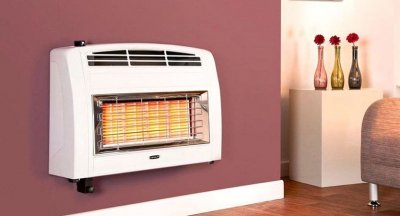
-
Open - is not isolated from the room in which the device is used.
The air for gas combustion comes from the room itself, so for these devices it is necessary to provide high-quality ventilation of the room (otherwise, during use, the air will be depleted of oxygen).
A traditional chimney is used to remove combustion products.
- In heaters with closed combustion chamber, oxygen for the gas-air mixture comes from the street through a coaxial chimney. The latter is a design "pipe in pipe". The internal one removes combustion products, and the external one supplies air. Heaters of this type are much safer than the previous ones, have a higher efficiency and do not affect the air quality in the room. But installing a coaxial chimney is not always possible.
Such devices are often used as an alternative to the central heating system, in places where regular heating is required over a long period of time: country houses, apartments.
Classification by type of heat transfer
According to the type of heat transfer, the following types of heaters are distinguished.
Infrared
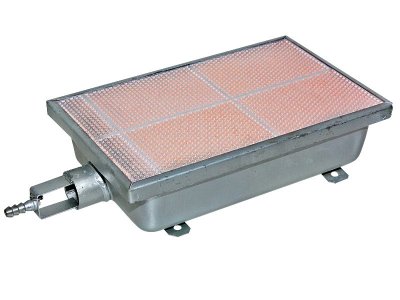
In traditional systems, heating devices primarily heat the air in the room, which is mixed through convection, distributing the temperature evenly.
This method is quite inert and requires a lot of time to establish the desired temperature, since the air has poor thermal conductivity.
Moreover, warm air does not mean warm objects and, for example, beds in a country house can remain cold for a long time, despite the fact that the room is already hot.
Infrared heaters are free from these disadvantages. Devices it's not the air that heats up, but the objects themselves in the room (furniture, walls, floors) and people in its area of action. Objects, heating up from IR radiation, themselves become small sources of heat and heat the air, and the person will not feel cold immediately from the moment the device is turned on.
Reference! The principle of operation can be compared to the Sun heating the Earth: despite the complete vacuum in space and the great distance, electromagnetic infrared radiation from the sun reaches the Earth and is absorbed by objects, turning into thermal energy, which we feel as the “temperature outside the window.”
The mechanism for obtaining IR radiation is as follows: the gas-air mixture enters the ceramic thermal panel, burns inside, heating it up to 800-900 °C. When heated to such temperatures, the panel becomes a source of infrared thermal radiation.
Infrared gas heaters are used:
- Where necessary local heating of premises. Heating occurs only in the area of the device, so it can be used to effectively heat the part of the room where people are.
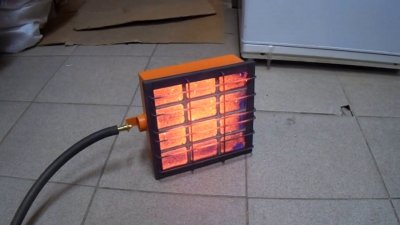
- Where necessary warm up the room quickly. The IR heater starts working immediately after switching on. At the dacha, this device will be the fastest way to warm up.
- On the streets. Infrared heating is the only option to provide comfortable conditions outside the home: in outdoor cafes, on verandas, gazebos, and at various outdoor events.
Infrared gas heaters operate on both liquefied and natural gas from the main gas pipeline.
Advantages of gas infrared heaters:
- Economy. By heating only the required area of the room and the absence of losses from the heat source to the radiators (as in a central heating system with a boiler), you can save up to 50% energy.
- Optimal heating of the roomWhen installing a gas IR device on the ceiling, it effectively heats the floor and the lower part of the room, which is most comfortable for a person. With convection heating, warm air often accumulates under the ceiling, and it is still cold below.
- Compactness.
- Fast and targeted heating.
- No need in the chimney.
Cons:
- High cost, compared to gas convectors and electric radiators.
- Regular cleaning and calibration is required, and repairs can be expensive.
- They burn oxygen in the room, so you need to take care of it ventilation.
Ceramic IR gas heater
The radiating element here is a panel made of heat-resistant ceramics with many holes. Passing through them, the gas burns and gives all the heat to the ceramic panel, which begins to radiate.
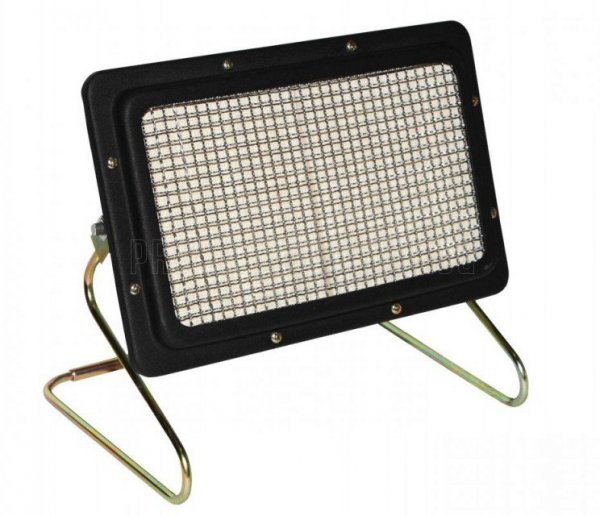
Photo 1. Ceramic IR gas heater model UK-04, thermal power 3700 W, manufacturer - "Neoclima",
This type of heating devices is also called “light” because due to heating to temperatures of the order of 900 °C They emit a glow that can create a pleasant atmosphere and harmoniously complement the interior.
Some models are equipped with built-in electric fan, which allows you to slightly increase its power, expand the area of action, and speed up the heating of the room.
Attention! When operating such systems for a long time, be sure to ensure fresh air intake into the room.
Moreover, most models of ceramic heaters are equipped with carbon dioxide and oxygen sensors, therefore, if there is insufficient oxygen in the room, the automation can simply turn them off.
Advantages:
- power;
- directed action;
- lower price compared to catalytic ones.
Flaws:
- a little more low efficiency;
- oxygen burning.
Catalytic IR heater
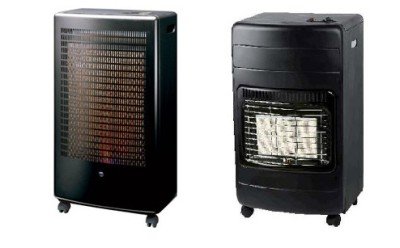
The name of these devices is due to the catalysis (acceleration) of the gas combustion process.
They consist of a refractory grate (usually steel or ceramic) which is covered catalyst substance - platinum and similar ones.
The gas supplied to the grate does not burn in the usual way, but is flamelessly oxidized by oxygen thanks to the catalytic coating of the thermal panel.
The catalyst promotes complete combustion of fuel, hence high efficiency (up to 80%). The combustion temperature of gas in such heaters below 600 °C, That is why they are sometimes called "dark". There is almost no glow during operation.
Thermal energy is also mainly transferred via infrared radiation, but in catalytic heaters it is more pronounced. convection heat transfer, than in “light” ceramic ones, where almost all the energy is emitted exclusively in the form of IR.
Pros:
- higher efficiency by optimizing the combustion process;
- less active combustion of oxygen (ventilation is recommended, but not as critical as with ceramic heaters);
- compactness and lightness.
Cons: limited power 2.9 kW (against maximum 5 kW for ceramics).
Convector
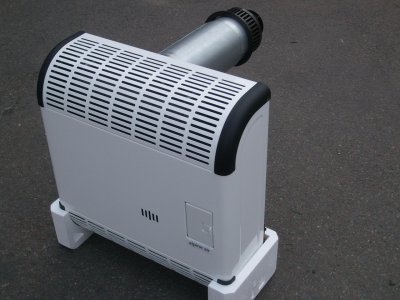
Unlike infrared devices, these devices use the traditional method of heat transfer through air: convection.
The main element in the convector is a metal chamber with a gas burner installed at the bottom. When burning, the gas heats the entire chamber, which gives off heat to the cold air.
As it heats up, it rises and ensures uniform circulation of heat in the room.
All models are equipped with automatic control, which monitors the room temperature and controls the gas supply, as well as safety sensors (CO2, gas leaks).
Convector gas heaters are produced only in a stationary version, since a chimney is required for their operation. The chimney can be either traditional type (for devices with an open combustion chamber), and coaxial (in case of a closed chamber).
Reference! For convectors with open the chamber receives oxygen from the room, so they require ventilation. Devices with a camera closed type are free from this drawback, the gas combustion process is completely isolated from the room and occurs, in fact, outside.
The heat exchanger chamber in convector heaters is made of steel or cast iron. Cast iron is more expensive and heavier, but more durable (service life up to 50 years), has a significant heat capacity (gives off heat for some time after the burner is turned off), and the efficiency of such devices is higher. Steel chambers are lighter, but their service life is 20 years old.
Application area: continuous heating of residential and technical premises, country houses.
Advantages of convector heaters:
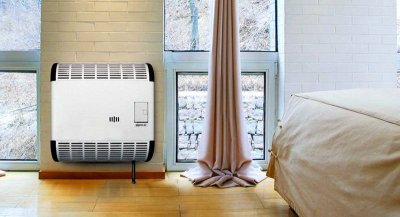
- Uniform heating, including large rooms.
- High power (up to 10-12 kW).
- Efficiency up to 92%.
- Autonomy.
- Undemanding to ventilation (for devices with a closed chamber).
Flaws:
- The need for construction chimney.
- Slow heating the room.
- To install a gas convector in an apartment you need permission from the gas service.
How to choose the right one for heating your home
The appropriate type of gas heater depends on the room, frequency of use and availability of gas.
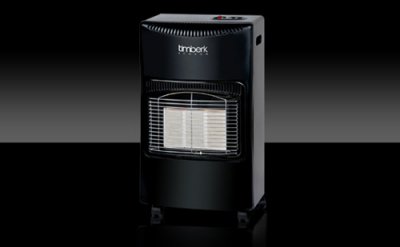
As with traditional heating systems, the first step is to determine the heating power of the device.
For typical houses in the middle zone, it is estimated approximately as 1 kW per 10 m2 area.
For small spaces (up to 20-25 m2) A catalytic heater would be a good choice due to its limited power (up to 2.9 kW) and cost-effectiveness of use.
If your room is larger, then an infrared device would be a suitable choice, since its power is higher, up to 5 kW and can warm up the premises up to 50 m2Considering the relative localization of this heating device, it may be more optimal to buy several such devices, placing them in different parts of the room to ensure uniform heating.
Give preference to IR heaters (catalytic and ceramic) is only worth it if you do not use heating constantly (for example, you come to the dacha on weekends).
Attention! Due to the open combustion chamber and interaction with the surrounding air, it is not recommended to use these devices in unventilated rooms with an area of less than 15 m2.
Otherwise, for continuous heating, you should use gas convector. This device will allow you to evenly heat large spaces without affecting the air quality.
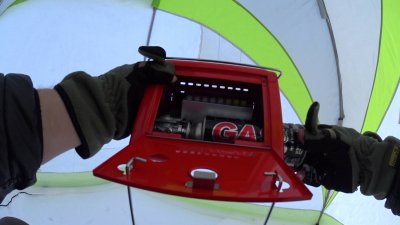
If temporary heating is needed (for example, while the stove is heating up), then these will do: portable liquefied fuel heaters. Also, pay attention to what gas the selected device operates on.
If you have permanent heating, you should give preference to natural gas from the network to save yourself from refilling cylinders.
Only IR heaters with are suitable for outdoor use ceramic thermal panel. They are often released in the form of "thermal umbrellas" or pyramids, for vertical installation.
Portable infrared mini ovens can be used in garages and utility rooms, as well as on hikes and picnics.
When purchasing a portable heater, ask about the presence of protection (from tipping over, gas leaks, excess CO2), especially if there are small children or animals in the house. Such systems will make the operation of the device absolutely safe.
Device with built-in cylinder: features
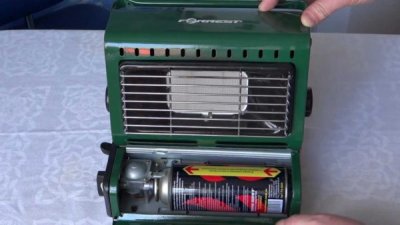
When choosing a gas heater with a cylinder, you need to pay attention to some small details.
For operation on liquefied gas gearbox required, which reduces the gas pressure before it enters the burner. Check if it is included.
Next, estimate the operating time of the device so as not to burden yourself with constant replacement of cylinders. The consumption of IR heaters on gas is within the range from 100 to 200 gr. gas per hour.
When placing the cylinder, make sure it is far enough away from the burner to avoid ignition and explosion.
A short overview of popular models
The following models are particularly popular.
Ballu BIGH-55 on propane
Ceramic IR heater with cylinder.
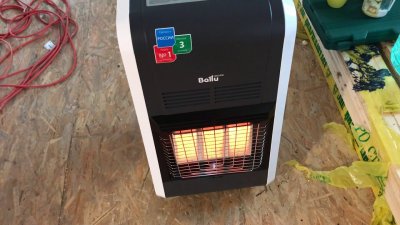
- Power 4.2 kW.
- Heating area up to 60 sq. m.
- Fuel: liquefied gas (propane).
- Built-in cylinder installation (up to 27 l, or up to 38 hours operation at maximum power).
- 3 power levels, piezo ignition.
- Protections: from tipping, CO control2, flame control.
- Wheels for transportation.
- Price: 6690 RUR
PATHFINDER-Heart
IR ceramic heater portable.
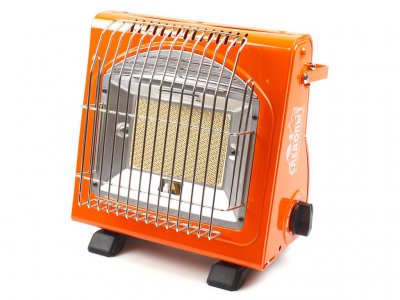
- Power 1.5 kW.
- Heating area up to 15 sq. m.
- Fuel: propane-butane-isobutane mixture.
- Work on cheap compact collet cylinders (up to 3 hours).
- 3 power levels, piezo ignition.
- Opportunity cooking.
- Price: 2700 RUR
Bartolini Pullover K turbo-plus
Catalytic infrared heater with built-in fan and heating element.
- Gas power up to 2.9 kW, electric up to 2 kW.
- Heating area: 35—60 sq. m.
- Fan heater allows you to warm up the room faster.
- Fuel: liquefied gas (propane).
- Built-in gas cylinder (included, 27 l).
- 3 power levels gas burner + 2 power levels fan heater.
- Protections: from tipping, CO control2, flame control.
- Wheels for transportation.
- Price: 15 thousand rubles.
AESTO A01
IR ceramic outdoor heater "thermal umbrella".
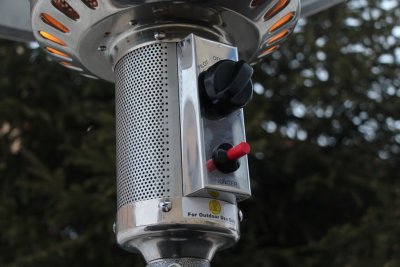
- Power: 5-13 kW.
- Heating area (outdoors): 10-20 sq. m.
- Fuel: liquefied gas (propane-butane).
- Built-in cylinder installation (up to 27 l).
- Height of the device: 2.2 m.
- Adjustment power.
- Price: 10500 RUR
Alpine Air NGS-50F
Gas convector for wall mounting.
- Power: 4.25 kW.
- Heating area: up to 50 sq. m.
- Fuel: natural gas or liquefied (propane).
- Thermoregulator to maintain temperature.
- Electronic ignition, fully autonomous Job.
- Closed combustion chamber.
- Fan heater.
- Price: 25700 RUR
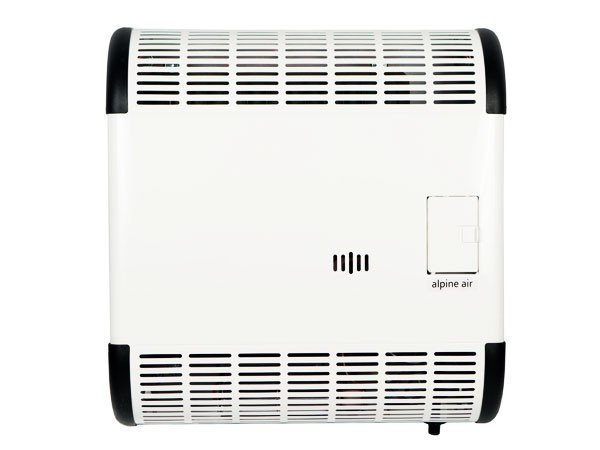
Photo 2. Gas convector with fan model NGS-50F, power 4.9 kW, manufacturer - "Alpine Air".
Useful video
Check out the video review of the BDN-100 portable gas heater.
A cost-effective replacement for central heating
Gas heating devices can be a good alternative to traditional heating systems with a boiler. But do not forget that gas equipment can be dangerous, so follow simple safety rules:
- Provide good ventilation for devices with an open chamber.
- The device heats up during operation. to very high temperatures, don't touch it.
- It is forbidden dry clothes on the grate of a gas heater.
- Do not move the device in working order.
Important! Do-it-yourself gas equipment repair is potentially dangerous!
- Do not use open flame appliances near fire hazardous items (this especially applies to garages and utility rooms).
- If you smell a strong gas odor, turn off the gas supply immediately, turn off electrical appliances, ventilate the room, and the heater itself should be submitted to a service center for diagnostics.







